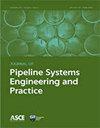求助PDF
{"title":"Generation of Synthetic Water Distribution Data Using a Multiscale Generator-Optimizer","authors":"Ahmad Momeni, Varsha Chauhan, Abdulrahman Bin Mahmoud, K. Piratla, Ilya Safro","doi":"10.1061/jpsea2.pseng-1358","DOIUrl":null,"url":null,"abstract":": Rare or limited access to real-world data has widely been a stumbling block for the development and employment of design optimization and simulation models in water distribution systems (WDS). Primary reasons for such accessibility issues could include data unavailability and high security protocols. Synthetic data can play a major role as a reliable alternative to mimic and replicate real-world WDS for modeling purposes. This study puts forth a comprehensive approach to generate synthetic WDS infrastructural data by (1) employing graph-theory concepts to generate multitudinous WDS skeleton layouts through retaining the critical topological features of a given real WDS; and (2) assigning component sizes and operational features such as nodal demands, pump curves, pipe sizes, and tank elevations to the generated WDS skeleton layouts through a multiobjective genetic algorithm (GA) – based design optimization scheme. Thousands of such generated-optimized networks are statistically analyzed in terms of the fundamental WDS characteristics both collectively and granularly. An outstanding novelty in this study includes an automatedly integrated algorithmic function that attempts to (1) simultaneously optimize the generated network in a biobjective scheme, (2) rectify pipe intersections that violate pipeline embedding standards, and (3) correct the unusual triangular loops in the generator by honoring the conventional square-shaped loop connectivity in a WDS. The proposed modeling approach was demonstrated in this study using the popular Anytown water distribution benchmark system. Generation and optimization of such representative synthetic networks pave the way for extensive access to representative case-study models for academic and industrial purposes while the security of the real-world infrastructure data is not compromised. DOI: 10.1061/JPSEA2.PSENG-1358. © 2022 American Society of Civil Engineers. Author","PeriodicalId":16804,"journal":{"name":"Journal of Pipeline Systems Engineering and Practice","volume":" ","pages":""},"PeriodicalIF":1.7000,"publicationDate":"2023-02-01","publicationTypes":"Journal Article","fieldsOfStudy":null,"isOpenAccess":false,"openAccessPdf":"","citationCount":"3","resultStr":null,"platform":"Semanticscholar","paperid":null,"PeriodicalName":"Journal of Pipeline Systems Engineering and Practice","FirstCategoryId":"5","ListUrlMain":"https://doi.org/10.1061/jpsea2.pseng-1358","RegionNum":4,"RegionCategory":"工程技术","ArticlePicture":[],"TitleCN":null,"AbstractTextCN":null,"PMCID":null,"EPubDate":"","PubModel":"","JCR":"Q3","JCRName":"ENGINEERING, CIVIL","Score":null,"Total":0}
引用次数: 3
引用
批量引用
使用多尺度生成器优化器生成综合配水数据
:对真实世界数据的罕见或有限访问一直是开发和使用配水系统(WDS)设计优化和模拟模型的绊脚石。这种可访问性问题的主要原因可能包括数据不可用和高安全协议。合成数据可以作为模拟和复制真实世界WDS以进行建模的可靠替代方案发挥重要作用。本研究提出了一种生成合成WDS基础设施数据的综合方法,方法是:(1)利用图论概念,通过保留给定真实WDS的关键拓扑特征,生成大量WDS骨架布局;以及(2)通过基于多目标遗传算法(GA)的设计优化方案,将组件尺寸和操作特征(如节点需求、泵曲线、管道尺寸和储罐高程)分配给生成的WDS骨架布局。数千个这样生成的优化网络根据WDS的基本特性进行了统计分析,包括总体和粒度。这项研究中的一个突出新颖之处包括一个自动集成的算法函数,该函数试图(1)在双目标方案中同时优化生成的网络,(2)纠正违反管道嵌入标准的管道交叉点,以及(3)通过尊重WDS中的传统方形环连接来纠正生成器中不寻常的三角形环。本研究使用流行的Anytown配水基准系统对所提出的建模方法进行了验证。这种具有代表性的合成网络的生成和优化为广泛访问用于学术和工业目的的具有代表性案例研究模型铺平了道路,同时真实世界基础设施数据的安全性不会受到损害。DOI:10.1061/JPSEA2.PSENG-1358。©2022美国土木工程师学会。著者
本文章由计算机程序翻译,如有差异,请以英文原文为准。


